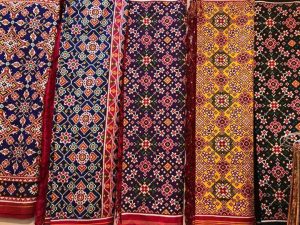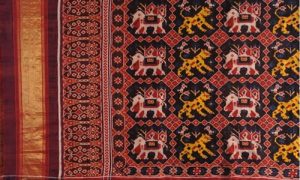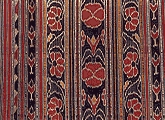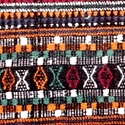Ikat or bandha of Odisha has gloriously woven, blurred, and gem-coloured motifs in silk and cotton. The dominant motifs in this craft include animals and birds, with the traditional designs being fish and conch shell as well as bolmala, chandankora, and sachipar. As the design-type is single ikat, the designs on the material are blurred; however, this trace-design has a beauty all its own.
The intricate process involves tie and dye — knotting sections of the yarn before dipping them in colours one at a time, and finally weaving them to produce motifs in multi-hued tones. While Sambalpur is famous for its double-ikat textiles, Sonepur is known for its gold embroidered ones.
Jaydev, the great poet offered Bandha woven calligraphy fabrics with lyrics of his poem the Gita Govindato the deities – Lord Jagannath, Balavadra and Devi Subhadra in the 12th Century. Since then the tradition of offering woven calligraphy Bandhas to the temples of Lord Jagannath is customary and part of the rituals conducted in worship.
Continuing Bandha weavings close link to the history of Odisha the early 14th century Maithili text Varna Ratnakar written by Jyotirishivara lists the Bandha tie-dye textiles by their lyrical names – the Surya Vandha or sun weave and GajaVandha the elephant weave. Vichitraand Vichitrangada are also listed, providing a continuing link with the Vichitrapuri sari woven till today.
In 1719, during the reign of Ramachandradeva the Second, who ruled over Puri, documents forming a part of Madala Panji, the daily diary of activities in the temple of Lord Jagannath talk of this offering.
While in Nuapatna, Cuttack District the weaving family of Kotual,as part of funereal customs weave Bandha fabric, a custom that goes back seven generations. As part of custom when the head of the family dies his successor adds on to the weave, after which he then removes the fabric woven by his predecessor and immerses it inthe holy river.
The Bandha tradition of weaving, both single and double ikat, continues, vibrant in Odisha today with cotton and silk extensively used. The villages of Kardola and Jhilimunda in Bargarh are said to be the oldest centers of ikat weaving in Odisha. Weavers traditionally belong to the Meher community. Weaving is now spread across the western districts of Sambalpur, Sonapur, Bargarh, Bolangir, Nuaparha and Kalahandi, and in the eastern region of Odisha.
Auspicious designs like rudraksh/Shiva seed, swan, machho /fish, phula /flower, singha/lion, mayuro/peacock, padma/lotus, baulmala/string of flowers, shankha/conch, harina/deer, elephant, and other motifs continue to be woven as part of the design vocabulary.


Gallery
YOUR VIEWS
PRACTITIONERS: INDIA
Access 70,000+ practitioners in 2500+ crafts across India.
BIBLIOGRAPHY
10,000+ listings on arts, crafts, design, heritage, culture etc.
GLOSSARY
Rich and often unfamiliar vocabulary of crafts and textiles.
SHOP at India InCH
Needs to be written.






